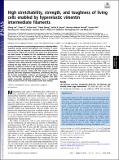High stretchability, strength, and toughness of living cells enabled by hyperelastic vimentin intermediate filaments
Author(s)
Hu, Jiliang; Li, Yiwei; Zheng, Tianqi; Gupta, Satish Kumar; Parada, German Alberto; Lin, Shaoting; Wang, Shida; Zhao, Xuanhe; Guo, Ming; ... Show more Show less
DownloadPublished version (1.243Mb)
Publisher Policy
Publisher Policy
Article is made available in accordance with the publisher's policy and may be subject to US copyright law. Please refer to the publisher's site for terms of use.
Terms of use
Metadata
Show full item recordAbstract
In many developmental and pathological processes, including cellular migration during normal development and invasion in cancer metastasis, cells are required to withstand severe deformations. The structural integrity of eukaryotic cells under small deformations has been known to depend on the cytoskeleton including actin filaments (F-actin), microtubules (MT), and intermediate filaments (IFs). However, it remains unclear how cells resist severe deformations since both F-actin and microtubules yield or disassemble under moderate strains. Using vimentin containing IFs (VIFs) as a model for studying the large family of IF proteins, we demonstrate that they dominate cytoplasmic mechanics and maintain cell viability at large deformations. Our results show that cytoskeletal VIFs form a stretchable, hyperelastic network in living cells. This network works synergistically with other cytoplasmic components, substantially enhancing the strength, stretchability, resilience, and toughness of cells. Moreover, we find the hyperelastic VIF network, together with other quickly recoverable cytoskeletal components, forms a mechanically robust structure which can mechanically recover after damage.
Date issued
2019-08-13Department
Massachusetts Institute of Technology. Department of Mechanical Engineering; Massachusetts Institute of Technology. Department of Chemical Engineering; Massachusetts Institute of Technology. Department of Civil and Environmental EngineeringJournal
Proceedings of the National Academy of Sciences of the United States of America
Publisher
Proceedings of the National Academy of Sciences
Citation
Hu, Jiliang et al. "High stretchability, strength, and toughness of living cells enabled by hyperelastic vimentin intermediate filaments." Proceedings of the National Academy of Sciences of the United States of America 116 (2019): 17175-17180 © 2019 The Author(s)
Version: Final published version
ISSN
0027-8424
1091-6490
Keywords
Multidisciplinary